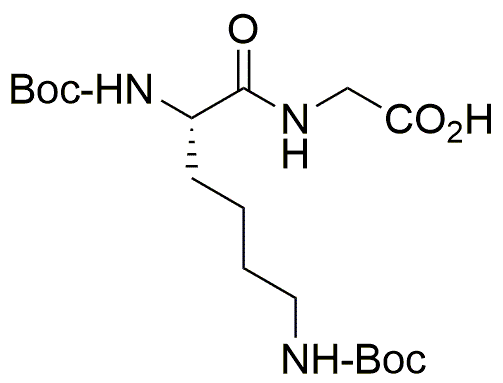Boc-Lys(Boc)-Gly-OH is widely utilized in research focused on:
- Peptide Synthesis: This compound serves as a key building block in the synthesis of peptides, allowing researchers to create complex molecules for drug development and therapeutic applications.
- Bioconjugation: It is used in bioconjugation techniques to attach biomolecules to surfaces or other molecules, enhancing the functionality of diagnostic tools and drug delivery systems.
- Protein Engineering: This chemical plays a critical role in protein engineering, helping scientists modify proteins to improve their stability and activity for various industrial applications.
- Research in Drug Design: Its structural properties make it valuable in drug design, particularly in developing inhibitors or modulators for specific biological targets, which can lead to new treatments.
- Cosmetic Formulations: The compound is also explored in cosmetic formulations for its potential to enhance skin penetration and improve the efficacy of active ingredients.
General Information
Properties
Safety and Regulations
Applications
Boc-Lys(Boc)-Gly-OH is widely utilized in research focused on:
- Peptide Synthesis: This compound serves as a key building block in the synthesis of peptides, allowing researchers to create complex molecules for drug development and therapeutic applications.
- Bioconjugation: It is used in bioconjugation techniques to attach biomolecules to surfaces or other molecules, enhancing the functionality of diagnostic tools and drug delivery systems.
- Protein Engineering: This chemical plays a critical role in protein engineering, helping scientists modify proteins to improve their stability and activity for various industrial applications.
- Research in Drug Design: Its structural properties make it valuable in drug design, particularly in developing inhibitors or modulators for specific biological targets, which can lead to new treatments.
- Cosmetic Formulations: The compound is also explored in cosmetic formulations for its potential to enhance skin penetration and improve the efficacy of active ingredients.
Documents
Safety Data Sheets (SDS)
The SDS provides comprehensive safety information on handling, storage, and disposal of the product.
Product Specification (PS)
The PS provides a comprehensive breakdown of the product’s properties, including chemical composition, physical state, purity, and storage requirements. It also details acceptable quality ranges and the product's intended applications.
Certificates of Analysis (COA)
Search for Certificates of Analysis (COA) by entering the products Lot Number. Lot and Batch Numbers can be found on a product’s label following the words ‘Lot’ or ‘Batch’.
Número de catálogo
Número de lote/lote
Certificates Of Origin (COO)
This COO confirms the country where the product was manufactured, and also details the materials and components used in it and whether it is derived from natural, synthetic, or other specific sources. This certificate may be required for customs, trade, and regulatory compliance.
Número de catálogo
Número de lote/lote
Safety Data Sheets (SDS)
The SDS provides comprehensive safety information on handling, storage, and disposal of the product.
DownloadProduct Specification (PS)
The PS provides a comprehensive breakdown of the product’s properties, including chemical composition, physical state, purity, and storage requirements. It also details acceptable quality ranges and the product's intended applications.
DownloadCertificates of Analysis (COA)
Search for Certificates of Analysis (COA) by entering the products Lot Number. Lot and Batch Numbers can be found on a product’s label following the words ‘Lot’ or ‘Batch’.
Número de catálogo
Número de lote/lote
Certificates Of Origin (COO)
This COO confirms the country where the product was manufactured, and also details the materials and components used in it and whether it is derived from natural, synthetic, or other specific sources. This certificate may be required for customs, trade, and regulatory compliance.


